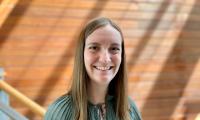Mette Krabsmark Borbjerg
DARE Fellowship: Monitoring blood glucose levels in children with diabetes
Mette Borbjerg’s project is devoted to the study of continuous glucose monitoring (CGM) – a new method for measuring the extent of hyper- and hypoglycaemia in diabetes patients. She will be working with the results of studies of children with diabetes and, among other things, will investigate the accuracy of CGM compared with conventional methods for glucose monitoring.
A prick of the finger produces a drop of blood that is then tested with a special strip or a pocket-sized measuring device.
This is the principle behind the conventional do-it-yourself glucose monitoring used daily by diabetics all over the world to keep track of their disease – and to ensure that they receive the correct dose of insulin.
However, blood glucose levels can also be monitored using CGM – a small device fitted to the diabetic’s upper arm. And this monitoring system does not involve any blood.
Instead, the blood glucose level is measured via a microscopic hypodermic needle, by analysing interstitial fluid. This is the fluid that surrounds our cells, and CGM continuously monitors the diabetic’s blood glucose level.
‘And I’ll be concentrating on CGM in my research project,’ Mette Borbjerg explains. Mette is 24 years old and is studying medicine at Aalborg University (AAU). She has one year left before she graduates as a doctor.
Mette Borbjerg will be working in the laboratory of her mentor, Associate Professor Jenise Wong, at UCSF. Jenise Wong is a paediatrician specialising in the design and refining of methods for monitoring blood glucose levels in children with diabetes.
Mette Borbjerg explains that CGM is a technology that is rapidly gaining ground in many countries.
‘It is primarily used today outside the hospital system. In Denmark, adults with type 1 diabetes use CGM to a certain extent at home to monitor their blood glucose level – and it is even more commonly used for children. The feedback is positive. For instance, many parents of small children say that the equipment has helped them get a good night’s sleep, because it has given them a sense of security. They no longer lie awake, wondering whether their child’s diabetes is out of control – because the device beeps if the child’s insulin level is either too high or too low.’
In Jenise Wong’s lab, Mette Borbjerg will be studying blood glucose measurements taken from around 140 children previously admitted to Benioff Children’s Hospital in San Francisco for treatment of their diabetes.
During their stay in the hospital, the blood glucose levels of these children were monitored both in the conventional way and using CGM. And these are the results that Mette Borbjerg will be delving into:
‘I’ll be investigating the reliability of CGM compared with conventional monitoring systems – and whether CGM is able to catch instances of hyper- and hypoglycaemia that are not detected by conventional methods. I’ll also be looking into whether it’s possible to predict the type – or types – of diabetes patient that would be likely to benefit from CGM. Both children and adults.’
Mette Borbjerg’s Danish mentors are Professor Niels Ejskjær, AAU and Aalborg University Hospital, and Professor Ole Hejlesen, AAU.
